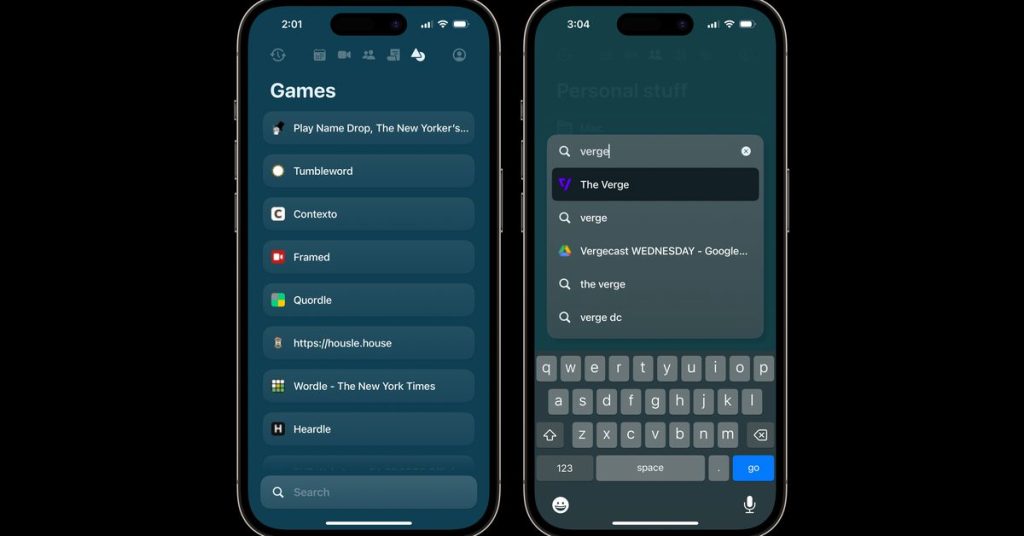
When the team at The Browser Company set out at the beginning of this year to build a mobile web browser, CEO Josh Miller made a rule: we are not allowed to build a default mobile browser. Building another Safari felt like a waste of time because, well, Safari exists. Because of the way Apple locks down browser development, pretty much every other browser on iOS is just another Safari. Besides, The Browser Company isn’t trying to build another web browser — it’s trying to build “the internet computer,” an operating system for the internet that changes the way we interact with apps and content online.
Instead of a browser, the team set out to do one thing and one thing only: bring users’ Arc sidebars to mobile phones. The sidebar is the core feature of Arc’s desktop app, one of the reasons it has become the most exciting new browser in years. It’s a combination of bookmarking tool and app launcher and offers a way to organize your whole online life in a way that makes sense to you. “When we did a survey with over 1,000 Arc members,” Miller tells me, “people weren’t like, ‘I really want a replacement for mobile Safari.’ Every single person was like, ‘I just want my sidebar on my phone.’”
That’s what Arc for mobile — codenamed Archie — is. The app is available today on iOS, though you’ll need an existing Arc membership to use it, which is still only available by invitation. (I’m told this link will work for 10,000 people, so get after it!) The app is very much just your sidebar on your phone. Someday soon, the app will need to be much more: Miller and The Browser Company do eventually hope to replace your default browser and to build its whole “internet computer” vision into a mobile app. But even in this early state, I’ve been surprised how useful it is to have my sidebar on my phone.
When you first open the app and log in to your Arc account, it immediately populates all the individual spaces you’ve created in the app. Spaces are, in this context, like pages on your phone’s homescreen. Each space can have its own background color and its own set of bookmarks and folders. There’s also a “Recents” area that shows your last few tabs opened across spaces. Tap on a link and it opens in the app; swipe down to close it and go back to your space. At the bottom, there’s a search bar, which you can use to do a quick Google or search across all your tabs and spaces.
What’s not in Arc’s app is most of the stuff you’d associate with a normal mobile browser. There’s no “new tab” button or persistent URL bar. If you open up the search menu and Google something, when you swipe down, that page disappears forever — unless you hit the pin icon and save it to one of your spaces.
Most of that stuff is missing on purpose, at least for now. The way The Browser Company sees it, basic web browser stuff and basic Arc stuff are two different things — and they’ve just picked Arc stuff to do first. The first version of Arc’s mobile app didn’t even have a web view, says Nate Parrott, a designer on the team. “We just opened Safari.” That felt like a step too far, so they built one, but the truth is, “it’s not a very good mobile browser,” Parrott says. “Because we didn’t set out to make an incredible mobile browser.” Internally, the team refers to it as a companion app for Arc.
In my time with the app so far, I’ve come to use Arc primarily for two things. One is just as a transfer tool: it is shockingly, stupidly hard to move webpages between phones and PCs, but Arc’s synced sidebar makes it easy. I can look up an address in Google Maps on my MacBook, then pin it to my sidebar, and it immediately shows up on my phone. One tap, and it launches right into the Google Maps app.
It is shockingly, stupidly hard to move webpages between phones and PCs, but Arc’s synced sidebar makes it easy
Oh, actually, quick diversion. The fact that that link opens the Google Maps app is the coolest thing about Arc’s app — and potentially the most transformative. On your laptop, Arc is a bunch of shortcuts to different web apps, but on mobile, it can also be a launcher for all the other apps on your phone. In that way, it’s more powerful than your homescreen — it can launch not just Notion but a specific Notion page, or a single YouTube video, or the exact file you’re looking for. I have an Arc space called “Queue” that is just links to Netflix shows, YouTube videos, New York Times articles, and everything else I want to get back to. All I do is tap the link, and then it opens in the right app.
That gets to the heart of The Browser Company’s whole “operating system for the internet” vision. One of the company’s biggest ideas is that, in a web-based, online world, everything is just a URL, which means everything can be linked to and accessed from anywhere. All you need is the thin client on top. So all Arc’s app is, really, is a bunch of nicely organized URLs, which makes it a pretty good launcher.
Okay, back to the other thing I use Arc for: random stuff collection. You can send stuff to Arc from other apps through the iOS Share Sheet, and I’ve found myself using it all the time for things I want to get back to later. Blogs to read, TikToks to send to my wife, that sort of thing. In most other browsers, all that stuff gets lost in the morass of my many (many) open tabs, but in Arc, I just pin things to the sidebar and can then flip through everything when I get back to my computer.
For what it is, Arc is great. It’s fast, the animations are lovely, and much of Arc’s normal polish is already in place, even in early versions. I don’t even mind that it doesn’t feel like a full browser — Arc’s forced minimalism makes the app feel much cleaner, and I need Google and bookmarks much more than I need a bunch of tab management. If you’re an Android user, it’s kind of like using the built-in search bar for everything; the ephemerality of everything is mostly a positive thing.
But now, allow me to make a very long and very incomplete list of stuff missing from Arc’s mobile app. You can’t access your favorites — those tabs pinned at the top of your desktop browser — which is weird because those are the tabs you presumably want most often. You can add to your pinned tabs but not the more temporary Today section. You can’t rename tabs or change their icons. You can’t create a new easel or note, two of Arc’s best built-in features, nor can you edit ones you’ve already made. (You can view them, though.) You can’t create a new space or change the colors of your existing ones. Browser extensions don’t work, and neither do “Boosts,” Arc’s mini-extensions that can change how individual sites work. You can’t choose which app to open various URLs with. Arc’s Library feature doesn’t exist at all on mobile, so there’s nowhere to save screenshots or downloads.
None of that is news to Miller and his team. I’m told most of it is on the roadmap. But they’re also not sure exactly how it’s all supposed to work. One thing that became clear in my conversations with The Browser Company team was just how much the development process has surprised them — and challenged their assumptions about how to challenge the industry’s assumptions about mobile browsers. The two-way sidebar sync turned out to be more powerful than they expected — so did the ability to deep link to other apps. What else might be left to figure out?
Going forward, Parrott says, “There’s very much an exploration of, like, what does it mean to create on the web, on a mobile device, that feels very different from desktop?” The team once built a way to save a page just by screenshotting it — a URL and your image would be saved to a stack somewhere. “But that wasn’t it, that wasn’t right,” he says, “but it reinforced the idea that the creation experience on mobile is just so different.”
For years, Apple has hamstrung what browser makers can do, but the Arc team seems to sense that things are about to change. So does the rest of the industry, by the way: Mozilla and Google are already building browsers that don’t use Apple’s WebKit rendering engine, which is currently required of all browsers on iOS. Whether regulators force Apple to open up or Apple simply decides to let its rules slide, the mobile browser wars might be heating up. Arc on the desktop is built on top of Chromium, and if Chromium comes to mobile, so could almost everything else in Arc.
Arc definitely does hope to beat Safari and become your default iOS browser — eventually. “I feel like the bar is pretty low in terms of innovation in the mobile browsing space,” Parrott says. “I have no doubt we can do it.” But building a better Safari isn’t the goal — the goal, as ever, is to reinvent what a mobile browser can be. All the browser features, Miller says, “will be secondary to the idea that David is a human being, David has stuff going on in his life, what does David need for that stuff? And to organize his digital life around his life.”
So far, that mostly just means having all my tabs everywhere. It’s a start.

 Latest Breaking News Online News Portal
Latest Breaking News Online News Portal




